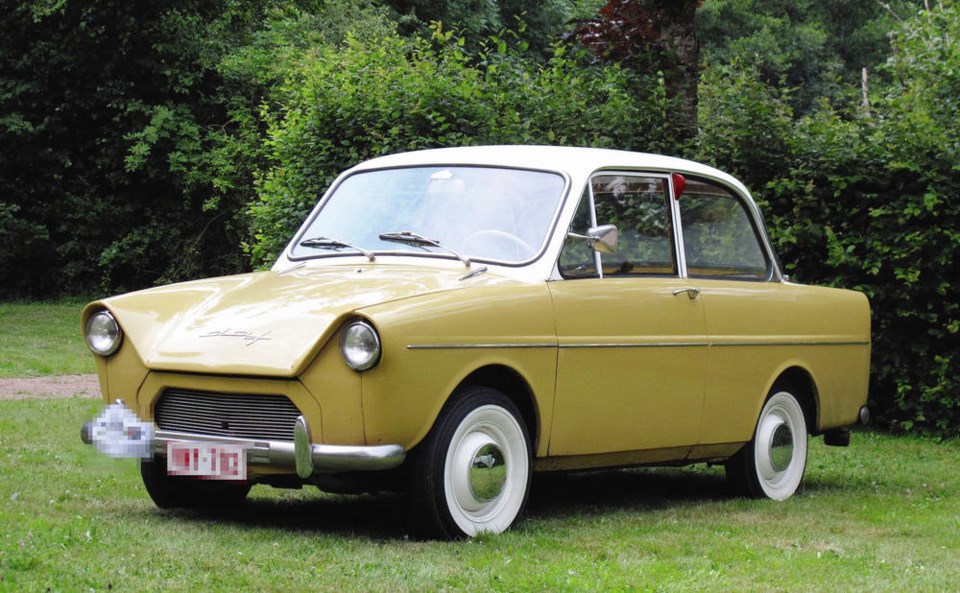Van Doornes Automobielfabriek (DAF) of Endhoven, the Netherlands, was far better known for commercial vehicles than for cars. But when it did start producing cars it introduced an innovation that showed promise: the continuously variable transmission.
The company had grown from a modest start in 1928 when brothers Wim and Hub Van Doorne began building ladders, metal cabinets and window frames.
They expanded into trailers, including semi-trailer trucks, four-wheel drive conversion kits for Fords and others and built their first complete vehicle in 1938. These were followed by six-wheeled, four-wheel-drive Ford V-8-powered military machines and a four-wheel drive amphibian with a Citroen engine.
Their next vehicle came in 1948, a 32-passenger trolley bus. Daf entered the commercial truck field in 1950 with a five-ton forward-control hauler and was soon building a wide range of medium and heavy-duty straight and articulated trucks.
After a few years, DAF announced it would build a car and showed its first one, the model 600, at the 1958 Amsterdam Auto Show. It was a trim, two-door sedan of conventional appearance except for the hood that sloped down steeply between the headlamps. Production began in 1959, the first Dutch car since Spyker ended production in 1925.
The little-unit-construction Daf 600’s main structure was a backbone frame that carried the front and rear suspensions. Car weight was 676 kg (1,490 lb) and it was 3,607 mm (142 in.) long. In spite of this and a short 2,050 mm (80.7 in.) wheelbase it accommodated four passengers and 12.5 cubic feet of luggage.
Suspension was four-wheel independent, by a transverse leaf spring in front acting as lower control arms. Upper control was by a combination sliding pillar/tubular shock absorber. At the rear were wide-based triangular links and coil springs.
Steering was rack-and pinion with a very responsive 2.2 turns lock-to-lock. Rubber bushings eliminated the need for chassis lubrication. Tires were small 5.20-12 with the wheels secured by three bolts.
A front, air cooled, flat-twin, light alloy, steel-sleeved, overhead valve 590 cc, 22 horsepower oversquare engine drove the rear wheels. Cooling was by a fan on the front of the crankshaft.
At the rear was the Daf’s most ingenious feature, the first successful production continuously variable transmission that matched engine output with the power demanded by the driver.
This “Variomatic” system made Daf the first small car with a standard equipment fully automatic transmission. With no gears to shift there was no clutch pedal. Engine power went through the chassis backbone-housed driveshaft to the rear-mounted transmission/final drive.
This was a continuously variable transmission with two identical reduction units, each comprised of two variable diameter pulleys, four in all.
These pulleys were connected by cogged vee-belts, and the continuously variable feature was achieved by changing the effective diameter of the pulleys by sliding one of the driving pulley flanges axially closer to or farther from the other.
The front (driving) pulley diameters were controlled by a combination of engine vacuum and centrifugal weights, while the rear (driven) pulleys were spring loaded and automatically changed diameter to keep belt tension constant.
Power went from the pulleys to the wheels via spur gears and swing axles. The drive ratio varied from 20:1 for starting, progressing to 4.4:1 as highway speed was attained. A potential problem in cold climates was fouling of the exposed belts by snow or ice.
Road & Track (9/60) found the Daf transmission did its job as intended. It provided smooth, clutchless driving while the engine was “churning away merrily,” and “engine revolutions (at full throttle) didn’t seem to change one iota from 10 mph to 50 mph.”
Performance was very modest with zero to 80 km/h (50 mph) in 41.5 seconds and top speed of 88 km/h (54.5 mph). Fuel economy was 31 to 40 mp U.S.g (7.3 to 5.6 L/100 km).
Although it could cruise at 64 to 80 km/h (40 to 50 mph) the pace dropped off quickly on hills. Testers found the ultra-fast steering quite sensitive, requiring constant attention. Price was in the $1,600 range.
In a quest for better performance the 1961 Daf 750 was introduced with 746 cc and 30 horsepower. There was also a deluxe version called the Daffodil.
More power was added over the years, culminating in the model 55 with a water-cooled Renault 1100 cc inline four with the Variomatic adapted to accommodate the increased power. The end came for Daf as an independent company when Volvo purchased it in 1975.
The CVT system was used in military vehicles and a Formula 3 racing car. It has also been in a variety of vehicles, but not widely, and is common in snowmobiles, golf carts and scooters. The CVT recently entered the mainstream car market in such marques as Nissan and Honda.



